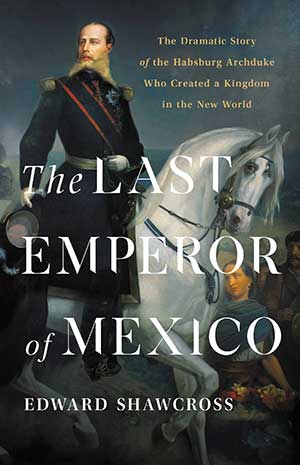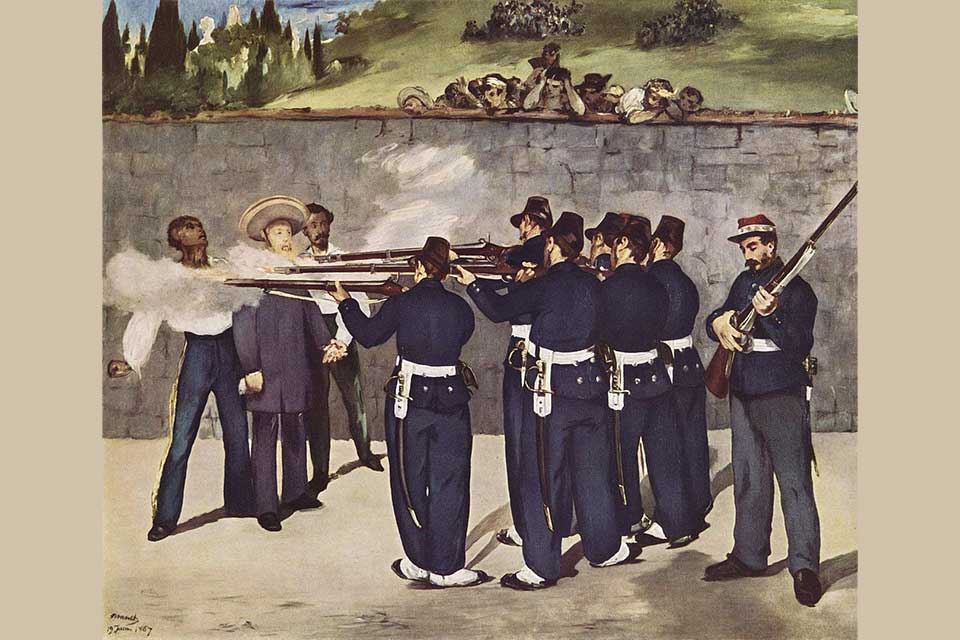Perched grandly and Viennese-pretty on a rocky promontory just north of the coastal city of Trieste, Miramare castle is a confection of a fortress. Built in the 1850s for Ferdinand Maximilian (1832–1867), the younger—and more popular—brother of the Austro-Hungarian emperor Franz Joseph I, the castle was extravagantly designed as a residence that befit a dreamer archduke who himself reveled in Habsburg history and aspired to a kingdom of his own. Maximilian settled in Trieste after being appointed commander in chief of the Imperial Navy, in part so his brother could remove him from the empire’s capital.
His castle was a continuation of a deep-seated obsession with dynasty, power, the arts, and exploration. Its name flaunted the magnificent sea view, while within its luxurious interior was a room inspired by the SMS Novara, the flagship of the Habsburg fleet. The castle’s appearance—a frilly concoction of Gothic, Renaissance, and medieval styles, immaculate in marble-like Istrian stone—gave the effect of a vast, castellated ship, gliding above the waves. In photographs, the whitewashed walls appear bleached to near overexposure against the brilliant sky and the Adriatic. This was fairy-tale territory extraordinaire and a perfect home for the wanderlust-fueled young aristocrat and his new wife: Carlota, the daughter of the Belgian king, Leopold I.
Yet soon after the castle’s completion, the husband and wife set off for Mexico, where Maximilian’s ambitions for power were set to come true with his unlikely election as the country’s new emperor. Three years after that, he was dead.
Shawcross’s book describes—with deep complexity—a history previous accounts have often reduced to a tale of mere farce, foolishness, and stock Habsburg tragedy.
 The little-known story of Maximilian’s short rule of a country across the Atlantic is the subject of Edward Shawcross’s new book, The Last Emperor of Mexico (Faber, 2022), which describes the potent blend of forces—part personal ambition, part geopolitical power struggle, and part (mostly French) imperialism—which contrived to create a Second Mexican Empire, a project that ultimately fell into staggering calamity. If you know the story at all, it may well be from Edouard Manet’s stark series of paintings depicting Maximilian’s final moments, The Execution of Emperor Maximilian (1867–69). Shawcross’s book is those paintings’ prequel, and the book describes—with deep complexity—a history previous accounts have often reduced to a tale of mere farce, foolishness, and stock Habsburg tragedy.
The little-known story of Maximilian’s short rule of a country across the Atlantic is the subject of Edward Shawcross’s new book, The Last Emperor of Mexico (Faber, 2022), which describes the potent blend of forces—part personal ambition, part geopolitical power struggle, and part (mostly French) imperialism—which contrived to create a Second Mexican Empire, a project that ultimately fell into staggering calamity. If you know the story at all, it may well be from Edouard Manet’s stark series of paintings depicting Maximilian’s final moments, The Execution of Emperor Maximilian (1867–69). Shawcross’s book is those paintings’ prequel, and the book describes—with deep complexity—a history previous accounts have often reduced to a tale of mere farce, foolishness, and stock Habsburg tragedy.
The book begins with an overview of the political instability that followed Mexican independence from colonial Spanish rule in the early nineteenth century. The rebel leader Agustín de Iturbide was briefly installed as Mexico’s first emperor in 1822 before being executed for treason two years later. There followed a series of territorial losses to the United States, culminating in the Mexican-American War of 1846–47.
The war was catastrophic for Mexico. The United States occupied the country, withdrawing only in exchange for further territory. The legacies of that conflict caused a political rift and civil war within Mexico. On one side stood the liberals, who sought to dismantle the influence of the Catholic Church and were led by Benito Juárez, a lawyer who had grown up in poverty. On the other side stood the conservatives, led by Miguel Miramón, a military commander. After a protracted struggle, Juárez’s forces emerged victorious but at vast cost, with debts to Britain, Spain, and France.
For France, recovering Mexican debts was not the only motivating factor for participating in the war. Aspirations for a French empire in the Americas—combined with the outbreak of the American Civil War in 1861—created the opportune conditions for intervention. Shawcross places much of the blame on Napoleon III. The nephew of Napoleon Bonaparte, Napoleon III inherited his uncle’s hubristic approach to foreign policy and saw Mexico as an easy target for imperialism, both in terms of its colonial revenue—which could be exploited to repay debts—and in its connections with exiled Mexican monarchists. During the war, France popularized the concept of Latin America as a cultural counterpoint to the United States’ influence; allied with Britain—another country concerned about US expansionism—Napoleon III sent thousands of French troops into Mexico and began to seek a ruler for its imagined Mexican kingdom. After some debate, Maximilian—who was available, Catholic, and had the correct historical pedigree as a descendant of Charles V, the ruler who had conquered central Mexico in the 1500s—emerged as the best candidate.
Maximilian is the particular subject of Shawcross’s book; brought to life as a blue-eyed and butterfly-beguiled archduke who abandoned discussions about his possible abdication in 1866 to admire the local insects. He is always seen with a card of life mottos to hand; indeed, one such card read, “Nothing Lasts Forever.” Though certainly romantic in his aspirations and in his hopes to redeem a previous, and ultimately disastrous, position as viceroy of the Kingdom of Lombardy-Venetia in the 1850s, he was also ambitious, liberal in politics, and held a genuine belief in international support. He wrote poems; he was a skilled linguist; he promoted political reform; he condemned slavery. Enamored of the possibility of becoming emperor, Maximilian was also pragmatically hesitant. He demanded he should only be appointed at the will of the people, and only with both French and British support. Maximilian was persuaded of the existence of these conditions by Napoleon III, whose reports back to the Habsburg archduke significantly underemphasized the insecure reality. French forces had only limited control of Mexican territory and struggled in difficult terrain; Britain, while recognizing the advantages of a European leader, was skeptical of the appointment; and monarchical support was by no means accepted across Mexico.
Even Maximilian’s arrival in Mexico in 1864 was far from the glory he had hoped; the streets lay deserted due to fears of yellow fever outbreaks and guerrilla forces. Maximilian attempted to win over Juaristas with liberal reforms and technological prowess. He also embraced Mexico’s Indigenous culture, being the first to publish policy in Nahuatl, the language of the Aztecs. But little was implemented in practice. Reports reached Napoleon III of lackluster governance, ongoing rebellions, and lavish spending on balls that were attended by the leading lights of European aristocracy. Then the American Civil War ended, and US troops and funds were donated to republican troops. Realizing the high cost and lack of progress, Napoleon III—whom Maximilian called his “best friend”—withdrew French troops from Mexico in 1866. Maximilian held out until the following year, sheltering in the city of Querétaro, but was ultimately captured and executed.
The Last Emperor of Mexico is an astonishing story, rivetingly told.
The Last Emperor of Mexico is a lively and well-researched account of this oft-forgotten episode in Mexican and European history. It is especially detailed in its analysis of Mexican politics, its recharacterization of Maximilian, and its expanded research on the Habsburg Empire, which is so often limited to discussions of multiculturality and artistic development in imperial Vienna. It is an astonishing story, rivetingly told, of the brazen and pomp-heavy ambitions of European colonialism, and of its empty realities.
University of Cambridge
